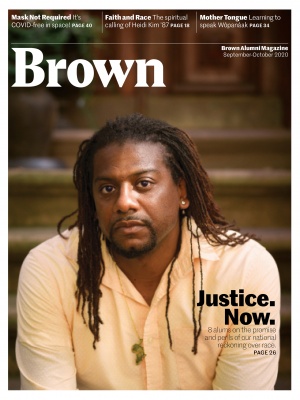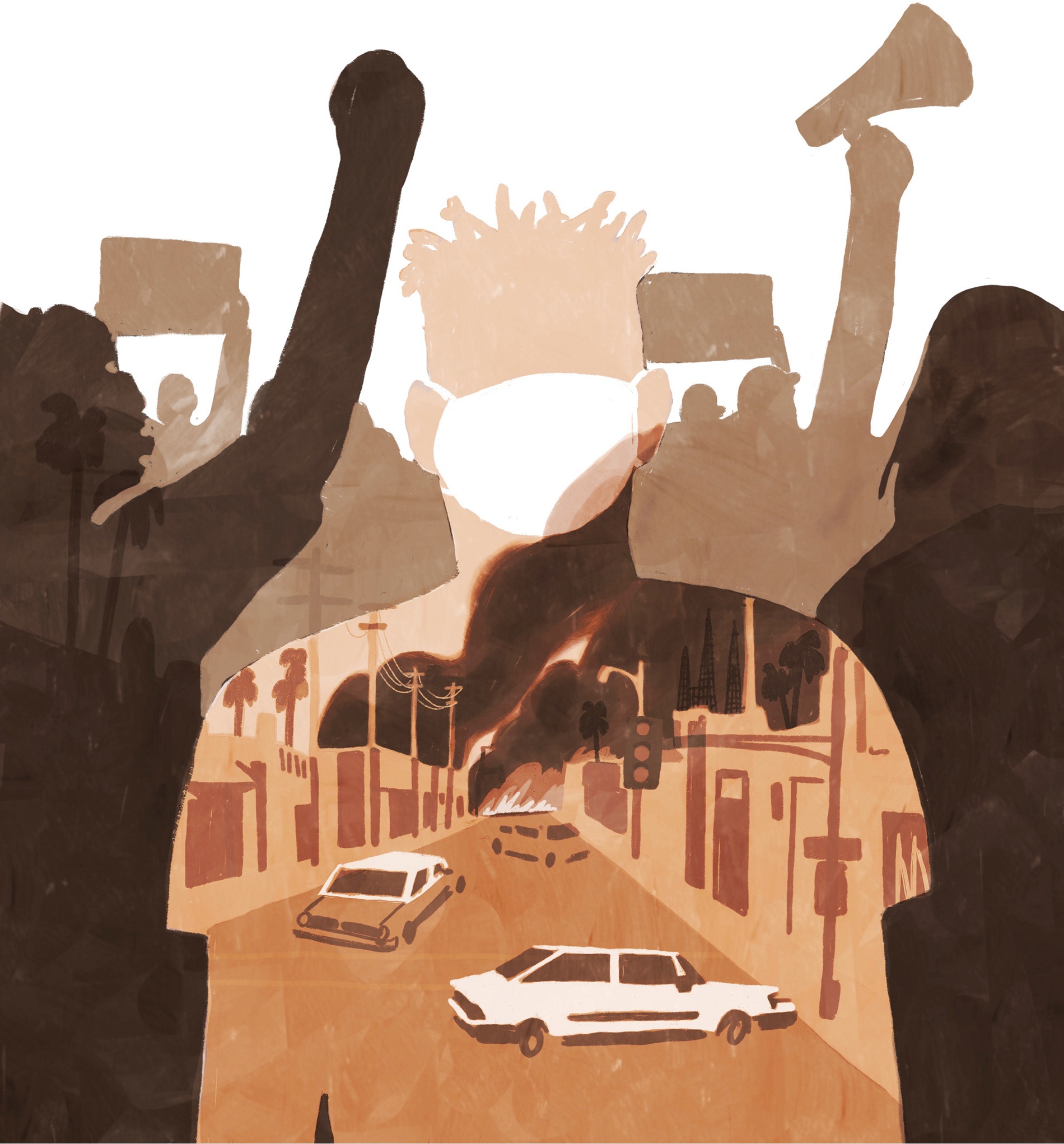
NOW!
Brown alums on this year’s nationwide demands for racial justice & the urgent need for lasting change
The day after the Rodney King verdict, while Los Angeles was still smoldering, I took the first cross-country flight I could. At the time, 28 years ago, I was an editor for The Source, the pioneering hip-hop publication, and those young people in the streets were our readers. Hanging out with protesters (and, yes, looters), I was struck by their optimism. Looters spared a surprising number of stores because of the positive way their owners treated the locals. Immediately, a gang truce was called, and there were demands for a social justice agenda including better schools, more healthcare facilities, and expanded job opportunities in South Central. The revolution was at hand. Or so many hoped.
“Black Lives Matter!” became the rallying cry after Trayvon Martin’s killer was acquitted in 2013. The next year, Eric Garner famously gasped, “I can’t breathe,” as he died in a police chokehold. Since then, the names of Black people killed by police—or whose murders by fellow Americans were met with indifference by law enforcement—has created a devastating, steady drumbeat.
Social media, fed by our now-ubiquitous cameras, has forced the entire world to bear witness to the obvious: racial injustice is baked into the DNA of our country. It’s become routine for all of us to see Black people die, but we’ve also seen the everyday, racially charged indignities. Bird-watching while Black. Delivering packages while Black. Getting coronavirus while Black.
And then we watched George Floyd calling for his mother while a policeman, hand casually in his pocket, crushed his throat. And that seems to have changed everything. Protests erupted nationally, in big cities and small towns, many predominantly white. Possibilities for real reform permeate the air. It feels as if, perhaps, parts of the larger social justice agenda imagined in South Central 28 years ago may become reality.
The BAM spoke with a variety of alumni about their thoughts regarding the present moment and their hopes for the future.—James Bernard ’87
Ashton Cumberbatch ’79
We have been here before. After King, there was an explosion of action, rebellion if you will. There have been other rebellions. What was a little different here was maybe an increased participation, not just of whites, but of whites you normally would not expect to be involved. Suburban whites in suburban neighborhoods where there isn’t a high concentration of Blacks, involved in, designing marches protesting against police brutality and explaining that Black lives matter. We have a broader scope of folks who are willing to get onboard and lend their voice and be true allies as opposed to cheerleaders.
My frustration is that you didn’t hear us before. You didn’t believe us before? Do you hear us now? —Ashton Cumberbatch ’79
My frustration is that you didn’t hear us before. You didn’t believe us before? The question, as one of my colleagues said, is, “Do you hear us now?” I want to be careful not to allow my frustration to prevent me from watching these guys do something beyond expectations based on that, that this in fact may be a new day. I just want to be careful that I don’t block that, that I am a facilitator for new policies, new procedures, and new alliances for substantial transformative change.
Cumberbatch is Executive Pastor of Agape Christian Ministries and president of Equidad ATX, an organization aimed at creating equity for underserved communities in the Austin, Texas, region. He’s previously worked in leadership at the Travis County District Attorney’s office and as police monitor for the city of Austin, and has also held leadership roles in education.
Michele Benoit-Wilson ’95, ’99 MD
Many of us feel that we are beyond the point of saying “Everything’s fine,” which has been our standard answer for decades. The reality is that it is not. The fear of death as a result of racist preconceptions is a constant in the life of a Black person. However, recently, people who are not Black are starting to recognize the realities of Black life in America. The conversations that we as a nation are finally having give Black people the space to be honest and say, “You know what? This is really hard. And it has been hard. This is not just one moment in time for us; this is our reality.” It’s suddenly okay and not considered impolite to say: “No, I’m really having a tough time right now.”
I’ve come to realize that many white people have been operating under the idea that the proper practice is being colorblind. However, it’s not helpful for you to pretend that you don’t see that my children and I are Black. The reality is that in this country, we are not all treated the same. If there’s potential for an unsafe situation, we, as Black people, need to react to it in a different way than others. I don’t know of any Black person that thinks this idea of being “colorblind” is safe for us.
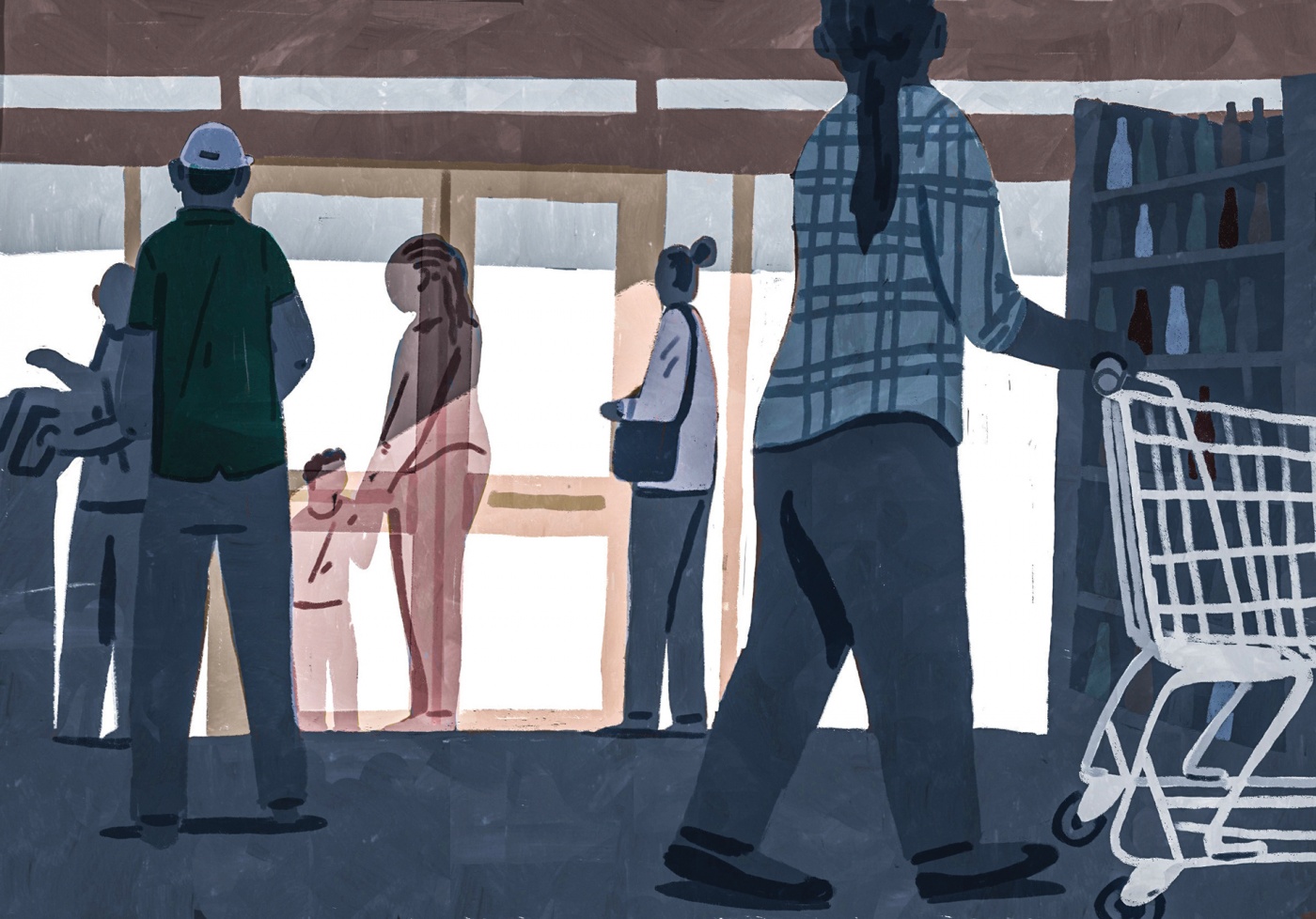
It’s not helpful for you to pretend that you don’t see that my children and I are Black. —Michele Benoit-Wilson ’95, ’99 MD
Clearly, there is a divide in understanding and as a result, we need to have very honest discussions with each other about how racism impacts people of color. Unfortunately, in order to do so, we need to share the trauma we have experienced. And the sharing must be done in a very mundane and relatable way so that people can start to understand that racism is not just about murder. It’s about our day-to-day life. Although white people engaging with other white people on the topic of racism is what ultimately needs to happen, I think that sharing our pain is part of the process that leads to change and understanding.
Benoit-Wilson is a board-certified ob-gyn practicing in Raleigh, North Carolina. She is a member of McStuffin Mommies, a Black physician moms’ advocacy group, and Delta Sigma Theta Sorority, Inc., a public service sisterhood.
Eldridge Gilbert ’05
As an educator, it’s hard right now to stand in front of Black and brown children and not know what to say and do, what to educate them on. There was a time period when I would have said, “Here’s how you need to talk to police officers. Here are the dos and don’ts.” Already, that is not something we should have to do. But now, even if I do that, I feel like it’s still no guarantee that a young person won’t end up gunned down or hanging from a tree. I’m frustrated and angry and somewhat hopeless that as we teach kids to advocate for themselves and have their own voice, there’s no guarantee that they won’t be pepper-sprayed or shot with a rubber bullet or dragged out of their car. And then you still have to go back in the next day and teach kids this myriad of things that they need to know in order to be “good citizens.”
The work that needs to be done amongst white people can’t be done fast enough to eradicate the fear that I have for my Black and brown girls and boys. —Eldridge Gilbert ’05
Black students come into the room with all sorts of innate experiences that are beautiful and wonderful, and as educators we’re trying to add to that but simultaneously sending kids out into a world that may not appreciate any of that. The work that needs to be done amongst white people in white communities across the United States can’t be done fast enough to eradicate the fear that I have for my Black and brown girls and boys. We are racing against time for our kids to be able to have the future that they want, and that race is frustrating to have to participate in.
Gilbert serves as chief schools officer for Coney Island Prep charter schools. He also coaches principals, leads Diversity, Equity, and Inclusion training for the KIPP Foundation, and serves as president of Brown’s Inman Page Black Alumni Council.
Mara Gottlieb ’93
If racism is going to end, it’s because white people end it. And so it is my hope that there are enough white European folks who are feeling passionate enough about this and who now have enough education about it, that we can help turn the tide in a way that it did not get fully turned in 1965.
I feel fortunate at 50 years old to be living through a time when there is a potential for white people to engage in dismantling racism and to understand how it’s based on a house of cards, how it’s based on a lie, in a way that a lot of white people were not really willing to look at before.
Millennials have had people of color in their lives as role models, as stars of movies, as teachers, as lawyers, as public figures, in a way that I think makes it much more clear how ridiculous racism is. I don’t mean to oversimplify this, but there is a common sense piece to this that millennials get, because I think they are swimming in much more multiracial waters than many of us who grew up in earlier generations.
Part of white privilege is being allowed to be numb tothe atrocities that have happened, particularly to Black peoplein this country. We need to step out of that numbness. —Mara Gottlieb ’93
White privilege is something that we benefit from every day. And part of white privilege is being allowed to be numb to the atrocities that have happened, particularly to Black people in this country. That is a privilege. And we need to step out of that numbness and we need to face what we’ve done, and we need to feel our feelings about it in order to be willing to be fully active in the process of dismantling it.
Gottlieb is the president of Talking Changes, an anti-oppression and bias-reduction consulting firm.
Andre McGregor ’04
For black law enforcement, the thing to remember is you are still a Black guy with a gun. New officers and agents who are non-white have to be given “The Talk,” told early on that there will be situations where other cops are going to see them with a holstered gun on their side and not initially think that they are also a cop. Not all cops wear blue uniforms and have a badge on their chest, and criminals don’t typically wear holstered guns, so the whole experience is jarring when it actually happens for the first time. I used to carry my badge right next to my gun and hope that if something happens, the other officer will see a glimmer of gold coming from where my gun is and think “Wait, let me not shoot you.” I have always walked a tight line of making sure that I act a certain way, by going to the right schools and having the right jobs. But you know, at the end of the day, the George Floyd video taught me that I could always end up on the ground with a knee on my neck, regardless of how the rest of the world may perceive me.
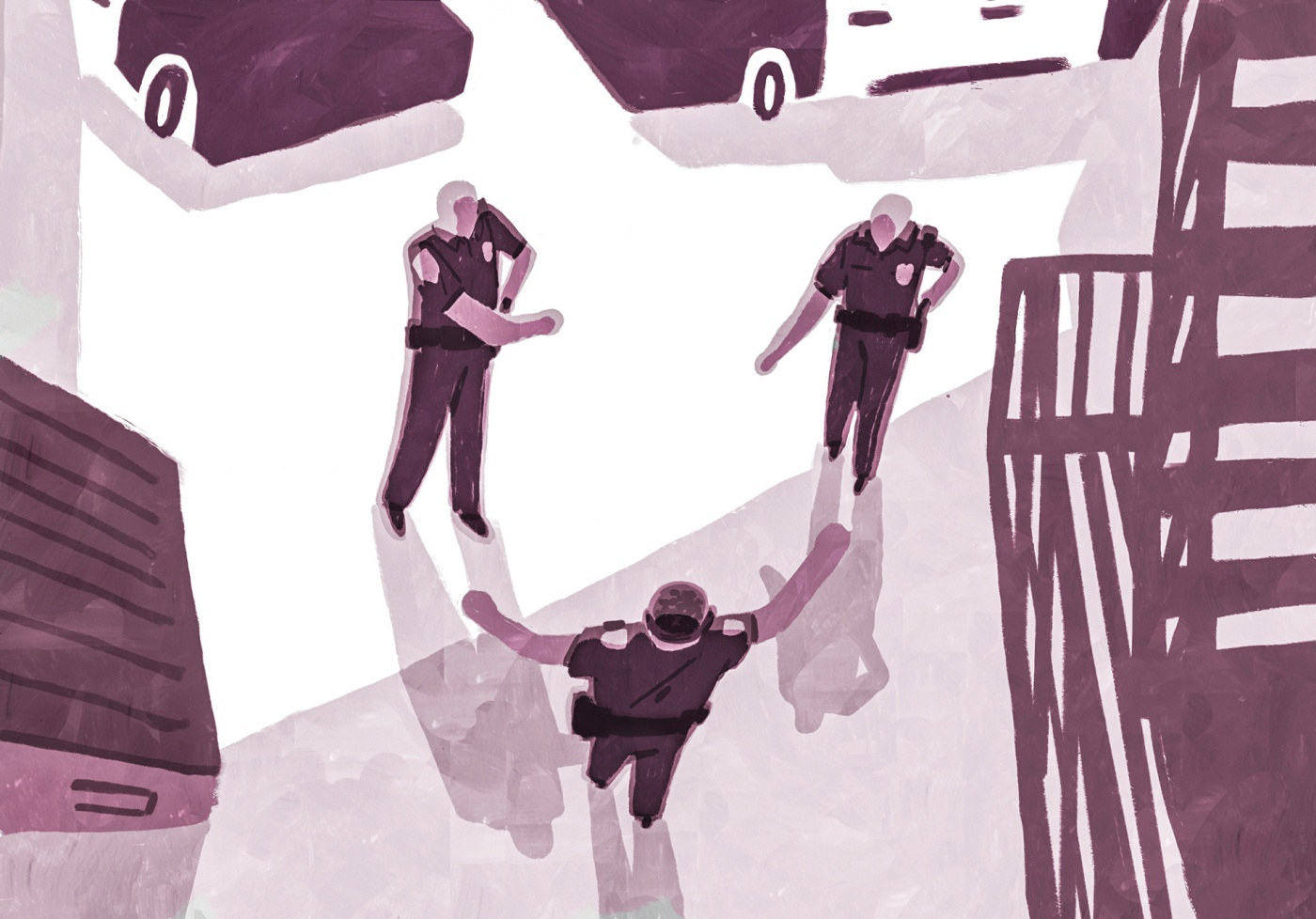
At the end of the day, I could always end up on the ground with a knee on my neck, regardless of how the rest of the world may perceive me. —Andre McGregor ’04
Defunding the police is a good sound bite, but a misnomer. Instead, we need to rethink how policing is done. We are expecting police officers to be social workers and therapists and homeless advocates, and they are not. The police should maintain hiring practices similar to that of the FBI where they are selecting top talent, not just weeding out bad candidates. Take, for instance, why not put a guidance counselor who already understands student culture through police training—rather than assigning a police officer with seniority but no student experience to work in a school.
In this time, however, we need to remember that it is not a robot having to deal with expletives and urine being thrown at them during these protests. A friend of mine had his patrol car lit on fire. He was with a rookie who had been on the job for a few months. The rookie broke down and then quit the next day.
Former FBI agent McGregor is CEO of ForceMetrics, a people performance analytics software platform, and chair of the Center for Social Impact Innovation.
Dréya St. Clair ’05
This notion that people are now starting to hear is a lie. You’ve been hearing us say these things, you just haven’t listened—white America has chosen not to listen for whatever the reason is.
If that camera wasn’t there on the day of George Floyd’s death, these protests would not be happening. The first question asked would have been, “What did George Floyd do to deserve this?” That would have been the story. Then, move on to the next one. Our narratives either are not believed or they’re ignored.
But even as we are asking for Black liberation, we want to make sure that all Black lives are valued. Murders of trans people are on the rise and most victims are Black transgender women. We are being killed predominantly by Black men who are sometimes in intimate relationships with us. I believe the root of these deaths is misogyny, and that it goes back to colonialism and white supremacy. Historically, men’s identity was constructed around their ability to protect their women and bring food to the table. All that was taken away by slavery. There was no autonomy. His woman could be taken and assaulted at any time by some white man. So now, in reclaiming the Black community, the main focus, at the expense of others in the community, has been rebuilding the Black man.
Toxic masculinity contributes to a culture where we don’t hold men accountable for all the harm inflicted by them, as is the case when Black men are disproportionately the ones to bring harm to Black trans women. And in this culture, women’s murders don’t get the same amount of public coverage and response as men’s—as in the case of Breonna Taylor, for example. We must make sure to center Black women in the movement for liberation.
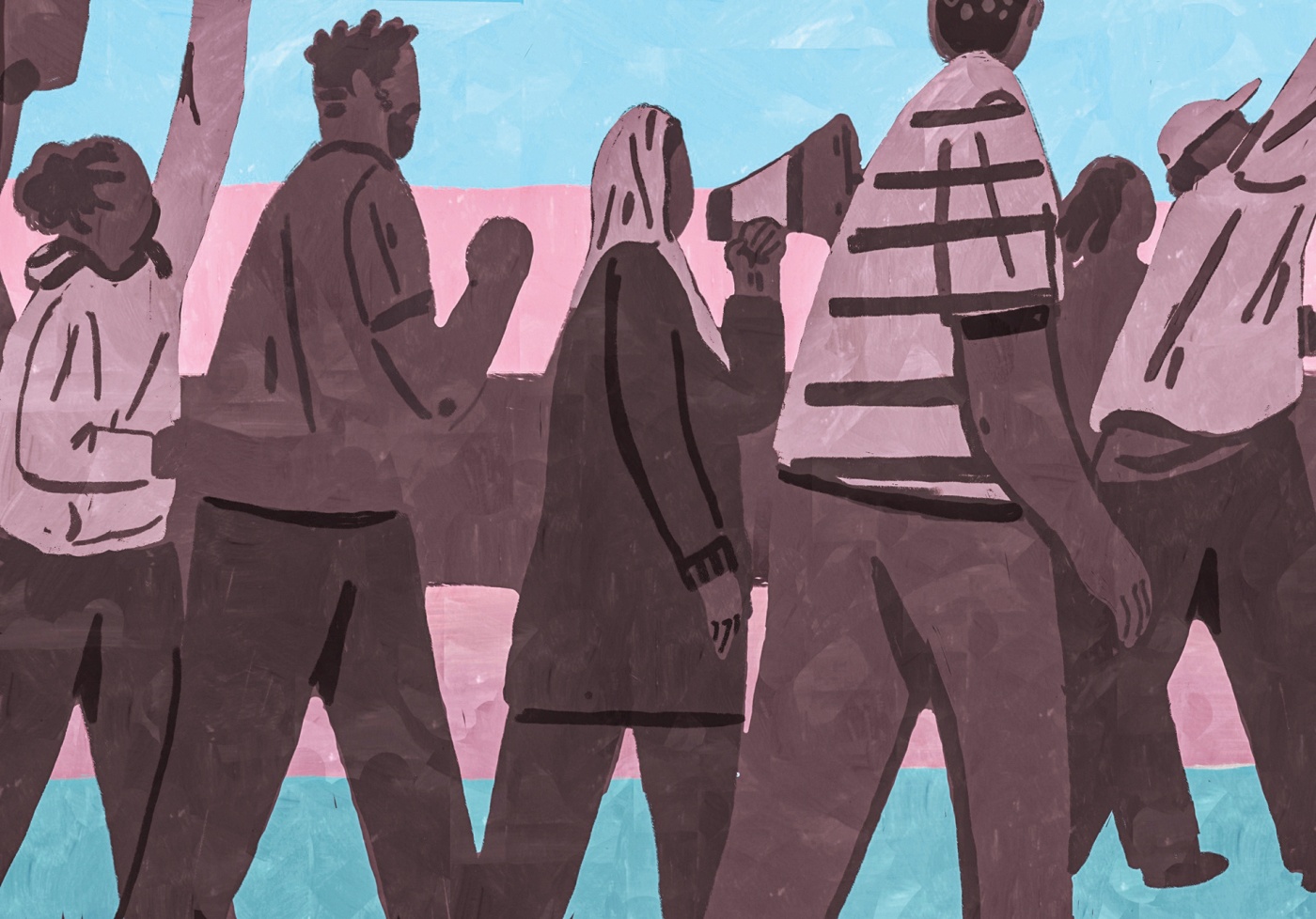
I want Black liberation. But I also do not want to see my trans sisters being harmed, and have people not cry for them in the same way I’m crying for men like George Floyd. —Dréya St. Clair ’05
In the wake of the George Floyd protests, a Black trans woman, Iyanna Dior, was beaten by a mob of predominantly Black men. As she was beat, they yelled all sorts of derogatory terms and misgendered her. Even while protesting George Floyd’s murder, Black people and people of color are ready to murder our own. I want Black liberation. I am Black. But I do not want to see one specific type of Black person liberated. I do not want to see my trans sisters being harmed and have people not cry for them in the same way I’m crying for men like George Floyd.
I’m worthy of the same kind of life, liberty, and pursuit of happiness as anybody else. Black trans and gender-nonconforming people are demanding that Black people in general bring up all Black people, regardless of gender and sexuality.
St. Clair is director of the Annual Fund at the NAACP. She is also an artist and advocate for trans rights.
James Forman Jr. ’88
This may be what it felt like to be in the early 1960s, when the sit-in movement started to spread across the South. It feels to me like this might be what it felt like when people started watching Bull Connor in Birmingham put his dogs on children. And a lot of Americans said, “We never knew that was happening.” Black people knew that for generations, but white people saw it on their news every night. And it was [so] blatantly unacceptable that it moved people to action. I don’t know if this is going to end up being like that, but I think it’s at least possible.
People are talking about doing things in the context of policing that were unimaginable, not 10 years ago—but 10 weeks ago. —James Forman Jr. ’88
People are talking about doing things in the context of policing and changing our criminal legal system that were unimaginable, not 10 years ago—it was unimaginable 10 weeks ago that these would be proposals that would be getting serious consideration. When the Minneapolis City Council decides that it’s going to spend six months to a year thinking through the question of whether it can disband its police force and create a new justice system from the bottom up—if you had told me that that would happen, I would have told you that you were dreaming. I think it’s an incredibly exciting time.
Forman is a law professor at Yale and the author of the Pulitzer Prize–winning Locking Up Our Own: Crime and Punishment in Black America.
Akilah A. Jefferson Shah ’05
There have been some arguments saying that doctors shouldn’t be out there protesting—“that’s not in their lane,” so to speak. I completely disagree with that. It’s 100 percent within any medical professional’s lane to go out and fight for people and patients to be able to live healthy lives, no matter what. White Coats for Black Lives is huge and very important, and I’ve been pleased that so many hospital systems—on the corporation side—are embracing that now.
I should be out here doing my work, not responding to microaggressions all day. But in this moment, I’m choosing to respond.” —Akilah A. Jefferson Shah ’05
The idea of being 100 percent honest and truthful for the first time is also giving me hope. For example, I go into my clinic every day, somebody says something crazy, and I have to decide, “Am I going to address this right now? Or am I going to brush it off today?” In the past, my choice has been almost never to respond, because I don’t have the energy for that. I should be out here doing my work, not responding to microaggressions all day. But in this moment, I’m choosing to respond, and I’m going to be 100 percent truthful. Even if it’s my boss, silence isn’t going to work anymore. The idea of hurting someone’s feelings because you’re telling them the truth is out of the window. We have to talk about it instead of putting our noses in the sand and just trying to make it through. “What you said was not right because of blank.” It’s not being rude; it’s trying to stop holding in all this hurtful stuff. And I hope that you take it the way that I mean it.
Jefferson Shah, an NIH-trained allergist and immunologist and expert in health policy and bioethics, is an assistant professor at U. of Arkansas’s med school.
Sheryl Brissett-Chapman ’71
It’s important for adults to take time to talk to young children.
And you can’t make an appointment with your kids, say, at dinner time, when you sit down and talk about what’s on your mind. That’s not how they work. You’ve got to take the questions and take the inquiry from them where they are when they’re available to talk, not on your schedule. Why are you upset? Why do you want to protest? Why are you turning up the news? Why are you yelling at Grandpa? If this does not occur spontaneously, ask them about what is happening, what they think is happening. What do they understand? That’s the best place to start, even when they do have a question.
Out of this very bad patch, we have to work hard to make sure we come out better, and if we can do that, then it might have been worth all of the pain.
—Sheryl Brissett Chapman ’71
You don’t need to rush to answer. How can you rush to answer when we as a society haven’t rushed to do much healing or remediation? Reconstruction was a joke. We’re still struggling with Confederate flags and what that means, so why rush to answer? Especially when you haven’t even had the time to figure out what’s beneath the questions. But we do need to openly seek those occasions when they are curious and have questions about what’s happening. They don’t need to be overwhelmed, and we don’t need to explain things to them as if they’re our peers. We can ask, what is the child looking at? What are they seeing?
You’ve got to convey from your heart that we will get through this and past this. We can get through loss, we can get through pain. You’ve got to reassure them in the midst of this reactivity. Out of this very bad patch, we have to work hard to make sure we come out better, and if we can do that, then it might have been worth all of the pain.
Chapman is executive director of the National Center for Children and Families. A passionate advocate and internationally recognized expert in child and family welfare, she publishes and presents on a wide range of topics including juvenile justice, systems reform in child and family welfare, poverty and homelessness, childhood trauma, domestic violence, and cultural competency. Chapman is an Associate Professor at Howard University School of Social Work. Recently, Brown conferred an honorary doctorate to her in recognition of her achievements as an advocate and nonprofit innovator.
Miré Regulus ’91
There’s this way, both being in Minneapolis and as an African American, that when George Floyd was killed, it was nothing new. Jamar Clark was killed in Minneapolis in 2015. Philando Castile was killed the next year. Those are names that have national prominence. But in terms of the real struggle in Minneapolis with police and the way they treat BIPOC [Black, Indigenous, and people of color], it’s not new. This time the heartbreak and the anxiety and the terror rebroke open.
The people that I consider my family, my folk, my heart—the vast majority of them are right in the heart of it. My partner lives three blocks from where George Floyd was killed. My best friends, one of them lives two blocks the other direction. One of them lives three blocks the other direction. One of them lives five blocks in the other direction.
The heartbreak and the anxiety and the terror rebroke open.
—Miré Regulus ’91
It’s a breaking point for everyone nationally, but here we’re at that point where we have seen this happen time and time again, and we have been doing enough work to be able to offer alternatives. It’s been a long time coming, but it has really started to crystallize in this last version of the city council and the mayor, where racial equity has really, really become part of how they walk the walk, and talk the talk. Nobody thinks the city council is perfect, but they have been starting to really try to hold both the officials and community accountable.
I feel like there’s a social justice movement that's been happening. There are a lot of white people showing up, and there are a lot of young people showing up. They still turn to people of color, saying, “Where do I plug in and what do I do?” We need to do this work together. But white folks need to be educating other white folks.
There’s this moment where people start to say enough is enough, and there’s enough engagement in a whole bunch of ways that it begins to have power. That it begins to have capacity. That it begins to have possibility. This is not going away. What it looks like or what we gain, I don’t know, but it’s not going away. It’s not going away.
Miré Regulus ’91 is a Minneapolis-based multidisciplinary community builder and parent. She lives and does her performance/creative and food-justice work at the intersection of the BIPOC, queer, political, and artistic communities, seeking to build a more equitable and embodied world.
Quotes in this story have been edited and condensed.
James Bernard ’87 is a founder and former senior editor of The Source. He lives in Brooklyn with his wife and three children, including Jefferson Bernard ’22. Lauren Campbell ’21 is a food and culture concentrator and creator of adashofawkward.com. Ivy Scott ’21 studies international journalism and French. Her writing has appeared in the Providence Journal and the Boston Globe.

